Winter can be a tough season for gardeners and plant lovers. The lack of sunlight, cold temperatures are the main dificulty to growing the plants. Also, dry weather can make it difficult to keep plants alive.

However, several houseplants are known for their beautiful blooms during the winter months.
Here are seven captivating plant choices to bring floral cheer into your home.
In This Article
Amaryllis
This bulb plant is a popular choice for the winter season due to its large, showy blooms. They come in various colors including red, pink, and white.
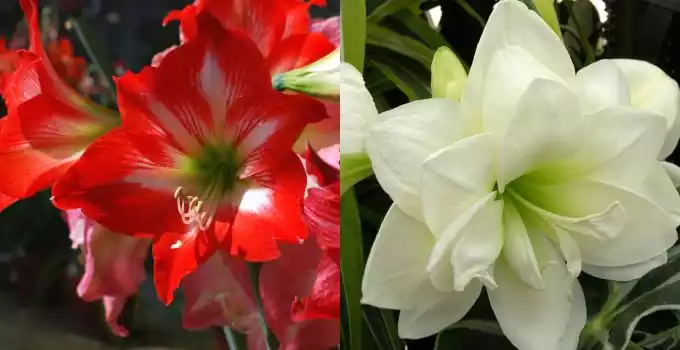
Amaryllis prefer bright and indirect light, they don’t need any direct sunlight. It should be watered sparingly to avoid root rot.
Amaryllis plants contain substances that can be toxic to humans and pets if ingested.
Specification of Amaryllis
These are the important specifications of this plant.
| General Name | Amaryllis |
| Scientific Name | Hippeastrum |
| Plant Family | Amaryllidaceae |
| Mature Size | 1–3 ft. tall |
| Flower color | Red, pink, white, orange |
| Blooming Time | Late winter to early spring |
| Light | Bright but indirect light |
| Type of Soil & water | Requires well-draining soil & moderate watering |
| Native Area | South America |
| Toxicity | Toxic to both humans and pets if ingested |
| Growing Season | Winter to spring |
- Amaryllis bulbs can be purchased pre-planted or as bare bulbs.
- After flowering, allow the foliage to die back naturally before storing the bulb for next year.
Christmas Cactus
This cactus is known for its winter blooms. This houseplant is very popular in the winter season. The colorful flowers have come in pink, red, and white shades. These flowers last for several weeks.

Christmas cactus prefer bright but indirect light and should be watered when the top inch of soil feels dry.
It is easy to propagate by stem cuttings. Remember, overwatering can create a problem.
Specification of Christmas Cactus
| General Name | Christmas Cactus, Schlumbergera, Thanksgiving Cactus |
| Scientific Name | Schlumbergera Buckleyi |
| Plant Family | Cactaceae |
| Plant Type | Succulent |
| Mature Size | 1-2 feet in height and width |
| Flower color | Red, pink, or white, but also found in orange, purple, and yellow |
| Blooming Time | November to December (also can bloom through February with proper care) |
| Light | Bright, indirect sunlight. Can tolerate some morning sun. |
| Type of Soil | Well-draining cactus mix |
| Native Area | Southeastern coast of Brazil |
| Toxicity | Non-toxic to humans and pets |
-Bonus Tips-
- Christmas Cactus need short days and cool temperatures to initiate blooms.
- Deadheading spent flowers encourages new blooms.
Cyclamen
This plant produces delicate, upswept blooms in shades of pink, red, and purple. Cyclamen prefer cool temperatures. It prefers bright and indirect light.
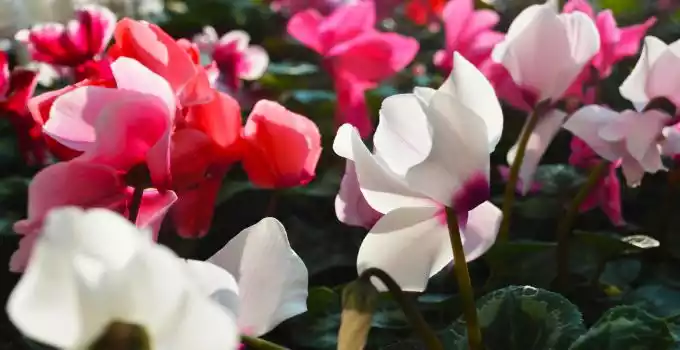
They should be watered from the bottom to avoid getting water on the leaves which can lead to fungal growth.
It is propagated by seed or division of the tuber although seed propagation is less common.
Specification of Cyclamen
| General Name | Persian Cyclamen, Alpine Violet, Sowbread |
| Scientific Name | Cyclamen persicum |
| Plant Family | Primulaceae |
| Plant Type | Tuberous perennial |
| Mature Size | 6-12 inches tall and wide |
| Flower color | White, pink, purple, red, salmon, and bicolor combinations |
| Blooming Time | November to February |
| Light Requirements | Bright, indirect sunlight. Avoid direct sunlight, especially during midday |
| Type of Soil | Well-draining potting mix specifically for cyclamen or African violets |
| Native Area | Mediterranean and Middle Eastern regions |
| Toxicity | Tubers are poisonous if ingested |
-Bonus Tips-
- Cyclamen is sensitive to drafts and sudden temperature changes.
- Deadheading spent flowers encourages new blooms.
Paperwhite Narcissus
These fragrant flowers are a popular choice for winter because they can be forced to bloom indoors. It looks amazing in winter.
Paperwhites prefer bright and indirect light. It should be planted in well-draining soil with plenty of space for their roots.
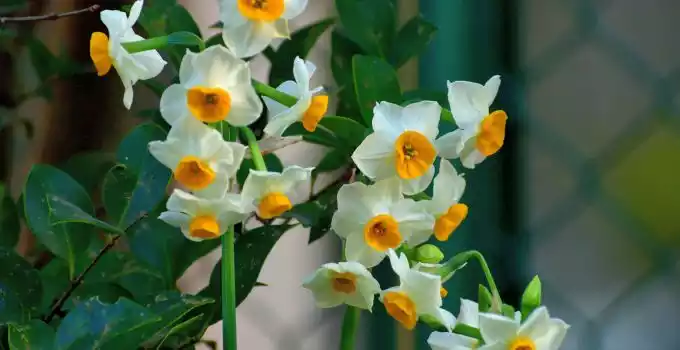
It is propagated by division of the bulbs after flowering and it can prefer slightly humid conditions
Specification of Paperwhite Narcissus
| General Name | Paperwhite Narcissus, Winter Daffodil, Tazetta Narcissus |
| Scientific Name | Narcissus papyraceus |
| Plant Family | Amaryllidaceae |
| Plant Type | Bulbous perennial |
| Mature Size | Typically grows 8-16 inches tall |
| Flower color | Pure white, although some cultivars have faint yellow trumpets or a green undertone |
| Blooming Time | December to February |
| Light Requirements | Bright, indirect sunlight. Avoid direct sunlight, especially during midday |
| Type of Soil | Well-draining potting mix for bulbs |
| Native Area | Mediterranean region, possibly South Africa |
| Toxicity | All parts of the plant are poisonous if ingested |
-Bonus Tips-
- You must wear gloves when handling bulbs because the sap can irritate the skin.
- After flowering, allow the foliage to die back naturally before storing the bulbs for next year.
Poinsettia
This classic and beautiful holiday plant produces bright red or white blooms and is often used as a decoration during the winter season.
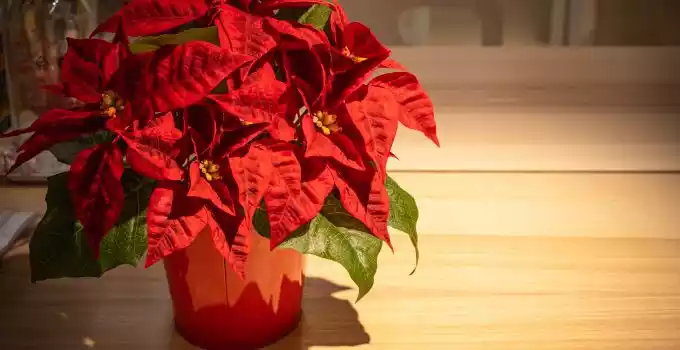
Poinsettias prefer bright, indirect light and should be watered sparingly to avoid root rot.
Specification of Poinsettia
| General Name | Poinsettia, Mexican flameleaf, Christmas star |
| Scientific Name | Euphorbia pulcherrima |
| Plant Family | Euphorbiaceae |
| Type of Plant | Shrub |
| Mature Size | 3–10 ft. tall, 3–7 ft. wide, 10ft outdoor |
| Flower color | Yellow, also has pink, white, or cream bracts. Green, lobed foliage forms a backdrop |
| Sun Exposure | Full, partial |
| Type of Soil | Loamy, well-drained |
| Native Area | Mexico |
| Toxicity | Toxic to both pets and human |
| Bloom Time | Winter |
-Bonus Tips-
- Poinsettias are sensitive to drafts and sudden temperature changes.
- Try to avoid placing them near heat sources like radiators or fireplaces.
Get Poinsettia Full Guide
| Poinsettia Plant Specification, Care, Propagation, Its Benefits & More Details | Explore |
Winter Jasmine
This is also a very popular plant in winter. This shrub produces bright yellow blooms during the winter months. It prefers full sun and well-draining soil.
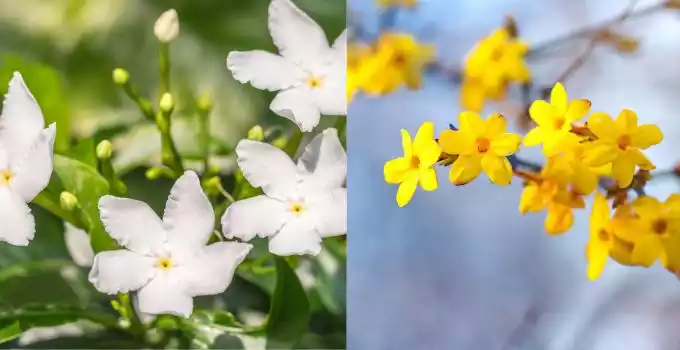
Winter jasmine can be trained to grow on a trellis or allowed to spread as a ground cover.
It is propagated by layering, semi-ripe cuttings, or from seeds. Mainly three types of Winter Jasmine are available.
- Common Winter Jasmine
- Winter Honeysuckle
- Star Jasmine
Specification of Common Winter Jasmine
| General Name | Common Winter Jasmine, Winter Jessamine, Winter Blooming Jasmine |
| Scientific Name | Jasminum nudiflorum |
| Plant Family | Oleaceae |
| Plant Type | Deciduous shrub |
| Mature Size | 6-10 feet tall and wide, but can reach up to 15 feet |
| Flower color | Vibrant yellow with five petals and a central cluster of stamens |
| Blooming Time | Late winter to early spring |
| Light Requirements | Full sun is preferred for abundant blooms |
| Type of Soil | Well-draining, fertile soil with slightly acidic to neutral pH |
| Native Area | Central and West China |
| Toxicity | All parts of the plant are mildly toxic if ingested |
-Bonus Tips-
- Pruning after flowering promotes bushier growth and more blooms for next year.
- The plant naturally forms a graceful vase shape, but light pruning can help maintain the desired form.
- Winter Jasmine is relatively pest and disease-resistant.
Winter Rose
This is one of the most beautiful plants for your house. Christmas Roses can bloom for many years with minimal care. This plant produces rose-like blooms in shades of pink, white, and red colours.
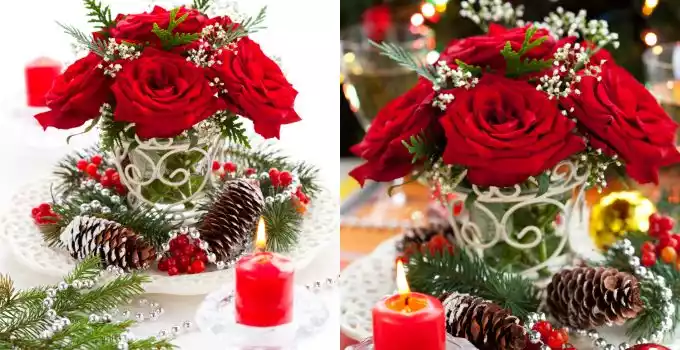
Winter roses always prefer bright and indirect light. They should be watered sparingly to avoid root rot.
So many types of roses are available in our nation.
- Hellebore
- Christmas Rose
- Lenten Rose
- Winter Iris
- Snowdrops
Specification of Christmas Rose
| General Name | Christmas Rose, Black Hellebore, Black Christmas Rose |
| Scientific Name | Helleborus niger |
| Plant Family | Ranunculaceae |
| Plant Type | Evergreen perennial |
| Mature Size | 12-18 inches tall and wide. But older plants can reach up to 2 feet |
| Flower color | white, soft pink |
| Blooming Time | Late winter to early spring (January to March) |
| Light Requirements | Shade or partial sun. Avoid direct afternoon sun |
| Type of Soil | Well-draining, fertile soil rich in organic matter |
| Native Area | Europe |
| Toxicity | All parts of the plant are poisonous if ingested |
-Bonus Tips-
- Christmas Roses prefer undisturbed soil, so resist the urge to transplant them frequently.
- Deadheading spent flowers encourages new blooms and maintains a tidy appearance.
Conclusion
These seven houseplants are sure to add some color and vibrancy to your home during the winter season.
With proper care and attention, they can produce beautiful blooms that will brighten up even the dreariest of days.
Read More Easy Plantation Method:



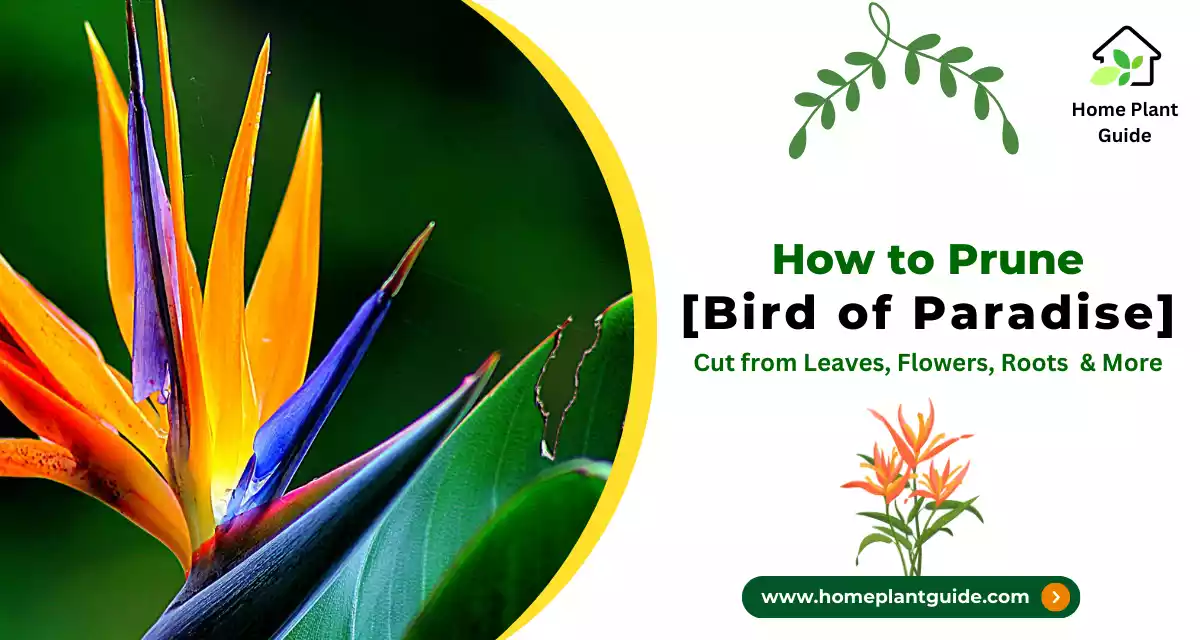


Thanks for sharing. I read many of your blog posts, cool, your blog is very good.